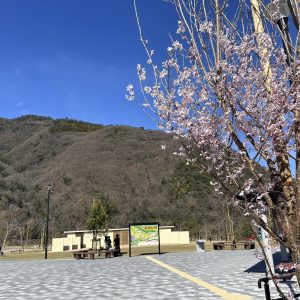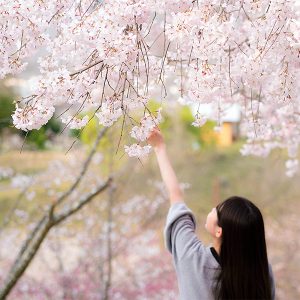TOURIST SPOT

Address:徳島県三好市池田町ウヱノ2903−1

Address:徳島県三好市井川町西井川1359番地1
Address:徳島県三好市井川町井関
This is a park located on a hill where you can enjoy a panoramic view of the Yoshino River which is famous for early-blooming cherry blossoms. At least 100 Someiyosihino cherry trees in full bloom fills the whole park in late March. Some playground, arbors, benches are ready for family picnics.
Address:徳島県三好市西祖谷山村善徳1204
Jindai Odori's root is said to be a rain-making ritual more than 1100 years ago, which makes it different from other Japanese traditional rituals like "Protection against evil" or "Repelling Insects" rituals. This is designated in 1954, as an important national intangible ethnic cultural property for its brilliance and valiance.
Address:徳島県三好市西祖谷山村重末249
Phone:0883-87-2322
The traditional drumming performance handed down from long ago at Hachiman Shrine of Shigesue which is said to be built in 1419 in Nishi-Iya Village. It is a prayer for the abundant to harvest of grains and to disperse devils, and is performed in the Autumn festival.
Address:徳島県三好市西祖谷山村徳善110
Fusuma Karakuri is a traditional performing art using a series of picture-painted sliding doors moving crisscross to show different images in turns. Tokuzen Fusuma Karakuri is very rare because it's performed on temporary built outdoor stages. The scale is a size larger than that of Usiroyama's, totally 57 fusumas of 9 sets. You can enjoy it with its local folk songs and dances during the autumn festval period. Miyoshi City designated it as a tangible folk cultural property. (On December 20 in 2012)
Address:徳島県三好市西祖谷山村後山289
Fusuma Karakuri is a traditional performing art using a series of picture-painted sliding doors moving crisscross to show different images in turns. Although this art had once disappeared during the post-war rebuilding and high economic growth of the 20th century, it was performed again with 69 on-fusuma pictures for the first time in 50 years on October, 2005. At present, you can enjoy it with its local folk songs and dances during the autumn festival period. Miyoshi City designated it as a tangible folk cultural property. (In February 2006)
Address:徳島県三好市西祖谷山村徳善110
Phone:0883-76-0877
Its origin is said to be a part of rainmaking rituals for drought-stricken farmers, while Sugawara-no Michizane was a guard of Sanuki. * It is performed during some October Saturday night programs of Fusuma Karakuri.
Address:徳島県三好市三野町芝生822
Yoshinaga, who became the origin of Miyoshi family later, constructed the castle. It is located in the area of a river terrace which is one step higher, the north of Prefecture Road 12. The name of the town subsection is "Breech Mansion". No remnants remain. Explanation boards have been placed where the castle once stood.
Address:徳島県三好市池田町サラダ1661
Ohnishi castle was demolished by the one castle one county policy of Tokugawa Era. So, the local samurais of Ikeda took over the resposibilities to keep law & order and to guard the county border after the demolition. This particular bukemon was constructed for the residence of Mamiya family, who was a local samurai warrior of Ikeda.
Address:徳島県三好市山城町寺野
This ruins of Tao Castle lies on the summit of Mt. Shiroyama at the altitude of 460 meters. It was the historic battlefield where the local warriors fought gloriously against the advancing army of Chosogabe in the 5th year of Tensho Period (1577).
Address:徳島県三好市山城町
Yamashiro Cho, renown for the magnificence of Oboke and Koboke ravines, and the beauty of Shiozuka plateau lies in the secluded part of Shikoku mountainous region. It was once a home of brave mountain samurai warriors who fought to protect their country border and is also a home of the Yokai (Hobgoblin) legend, which is quite unique in this country. The legend of Yokais has long lived on in everyday's life of local people here, its stories often being associated with the dangerous part of region. So, the hobgoblins or peculiar phenomenon were sometimes said to be a reminder to people to be diligent in general walk of life and also to respect nature and environment. These legends together with effort of local people trying to energize the community through a little unique and fun theme was recognized and acknowledged as “Yokai Heritage” by World Yokai Society in 25th May 2008. This is the second acknowledgement after Sakaiminato City in Tottori Pref. in its history.
Address:徳島県三好市池田町イタノ
The bridge over Ikeda dam / Yoshino river is the balancced arch bridge in Langer style(The world No.1). The sequence of five pillars with concreted arches, which can only be seen here, support this bridge. It is sited almost in the middle of Shikoku and is along Tokushima Express Way. There is the waterside park under the bridge.
Address:徳島県三好市三野町太刀野1909−1
Chuo Kozo-Sen is the fault line in geological term, dividing South Western Japan into the continental and pacific ocean side. It is the active fault line, which is the cause of the earthquake. The fault line stretches over the length of 1,000km across from Yashiro City in Kyushu, Matsuyama, Ikeda, Mino and Naruto in Shikoku, Kii peninsula, Ise bay, Tenryu River, Lake Suwa to even further Kanto mountainous region. This fault line is openly viewed at the next to the Roadside Station Mino.
Address:徳島県三好市三野町芝生
Shindayu Yamamoto was born about 200 years ago in Shibou and he was active in the provincial government office as a deputy along with the mayor Shube Hirao. In the 3rd year of Bunka-Era, the whole of north area of Yoshino river was hit with serious drought. Many farmers went hungry and suffered badly due to the heavy tax imposed. So bad was the situation, they fled to the neighbouring county, Sanuki. After the consultation with the mayor, Mr.Yamamoto made a plea in a letter to the governor of Awa-han so that they could carry out the work to make irrigation canal. He signed the letter with his own blood and put his life on line to commit a hara-kiri, were it not successful. This difficult work was completed after two years, but then, they encountered the another problem as the canal was kept being buried by the landslide every year. One day, he was inspired by the story of a coal miner and got an idea of digging the tunnel for the irrigation canal. Yet again he managed to get an approval for the suggested work in exchange for his property and wealth to tunnel the mountain and at last it was completed in the late autumn of 10th year of Bunsei-Era after overcoming many difficulties and sacrifices. The length of canal is 268.5 meters. This made the poor villages (Kamonomiya, Seiriki and Shibou whose staple diet was potatoes) enriched and they then became the granary of the area.
Address:徳島県三好市池田町ウヱノ2903−1
“Haru-Fukaki, Ochibana-no, Chiri-o-Fuminagara, Suwasandou-o, Noborikishi-kana” This stone monument was erected in memory of the fact that Isamu Yoshii composed the tanka-poem when he visited Ikeda Cho and enjoyed the Suwa park in 1937.
Address:徳島県三好市池田町サラダ 阿波池田バスターミナル
“Kizami-Tobacco-cha, Ikeda-ga-Honba, Mukashi-nagarano, Awa-kizami, by Ujyou” This short poem was composed by Ujyou Noguchi in 1936 when he visited Ikeda town. It consists of 15 verses and was named as “Ikeda-Kouta”.The monument inscribed with the 10th line extracted from the poem was erected near the Ikeda bus terminal (previously the site of the tobacco factory).
Address:徳島県三好市池田町白地本名76−2
“Tabi-ni-Nete, Nobinobi-to-Miru, Makura-Kana. 26th day, in Hakuchi” This haiku was composed by the authoress, Fumiko Hayashi who wrote the famous “Hourou-ki” (Wanderer) when she stayed at the inn in Hakuchi in 1941. She enjoyed her stay here and got on very well with then owner's uncle. It is well known that the heroes in two novels were modeled on him. This stone tablet, inscribed with a haiku composed by Fumiko Hayashi, was erected in honor of her.
Address:徳島県三好市東祖谷菅生28
The air in the forest feels cool, crisp and refreshing. It is believed this effect is due to the phytoncide given off by plants and trees. Please enjoy the slow monorail ride in the forest and that will give you the feeling as though you are trekking the mountain. You will appreciate the benefit of nature as people in Japan commonly engage in so-called forest bathing to breathe in phytoncides emitted to try to improve their health. The overall length of the monorail ride 4,600 meters, the difference in level 590 meters, the sharpest slope at 40 degree, the highest point at 1,389 meters, those figures at Okuiya monorails come first in the world record among tourist-orientated monorail service. *We adopt electrically powered monorails, which are environmentally friendly.
Address:徳島県三好市三野町太刀野1909-1
Phone:0883-76-2050
Rest Area Mino is situated by the prefectural road, Naruto-Ikeda line and this is the only spot on the north of river where you can stop and enjoy a fine scenery of Yoshino river. The view of the sun setting beyond the mountain and its reflection onto the river surface is particularly beautiful and is something not to be missed. The scene of people enjoying fishing Ayu (Sweetfish) in Yoshino river are seen here and there in summer, which is the thing of season. There also is the small shipyard of Kandori-Bune (Small fishing boat for Ayu fishing) nearby. Local farm products are sold directly to people and farmers are particular about their agricultural produce.
Address:徳島県三好市西祖谷山村尾井ノ内348-2
Phone:0883-87-2670
Rest Area Nishi-Iya is surrounded by the beautiful mountain scenery, with the winding Iya river running far below and its beauty of ravine. This place offers 24 hour rest room and other facilities as well as the sodium lighting at night providing an oasis of safety on the mountain. The adjoining shop sells local products and souvenirs. There are also hot springs and hotels nearby.